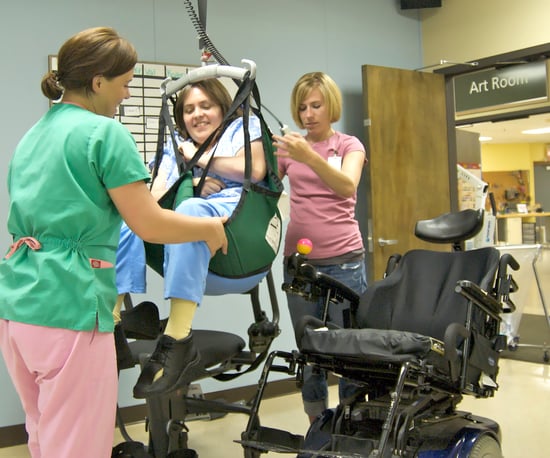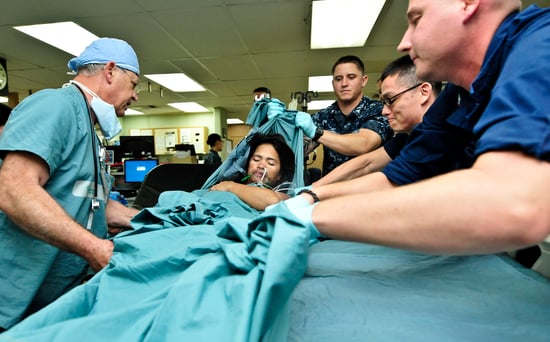3 Barriers to SPHM Program Implementation
by Larissa Biggers, on April 26, 2019
If you experience frequent pain as a result of performing a specific task, would you keep doing it? Maybe a professional athlete in the last mile of a marathon would—but what about healthcare workers for whom the race is far from over over? Injured runners, even amateurs, are advised to stop running and seek professional help to diagnose and address the pain, determine the cause, and fix the problem.

Unfortunately, the path for professional healthcare workers is not as straightforward. According to a recent American Nurses Association (ANA) Health and Safety Survey, 80% of nurses reporting pain from musculoskeletal disorders (MSDs) continued working through it. Most do not or cannot stop, see a doctor, and investigate and treat the problem. Causes of pain and injury to healthcare workers are well-known and include repositioning, transferring, and lifting patients.
A proven solution
The good news is that there is a solution to the injury problem—Safe Patient Handling and Mobility (SPHM) programs, which comprise policies and equipment that allow staff to care for patients in a way that does not cause strain or injury. When properly implemented and managed, they reduce the incidence of injuries to healthcare workers.

Here are two examples:
- Across seven southeast Veterans Health Administration (VHA) facilities, the employee injury rate fell by 30% after safe patient handling programs were introduced in 23 high-risk units.
- The patient handling injury rate in Tampa General Hospital in Florida was reduced by 65% after it established lift teams to perform patient transfers and repositioning tasks. In addition, there was a 90% reduction in lost work days, among other benefits.
Despite these and other success stories, there can be significant barriers to implementing SPHM programs and equipment use.
Barrier 1: Upfront cost
As healthcare facilities operate under increasingly tight budgetary constraints, the initial outlay of funds for SPHM programs can be a deterrent, but it should not be. Benefits of these programs include a rapid return on investment (ROI) because savings associated with reducing employee and patient injuries can be significant. For instance:
- Just three years after the University of Iowa Hospitals and Clinics implemented a SPHM program, workers’ compensation costs fell by 85% (from $559,610 to $84,880), and lost work days decreased by 76% (from 2,881 days to 529 days).
- The largest healthcare provider in western New York invested $2 million in a comprehensive safe patient handling program in 2004. Within three years it realized a full ROI, and by 2011, the five hospitals within the network had saved $6 million in patient handling injury costs.
Barrier 2: The status quo
SPHM is not universally taught in nursing schools for a variety of reasons, including traditional instruction on body mechanics, faculty unfamiliarity with ergonomics, a lack of SPHM equipment in laboratories, and the use of textbooks that don't include SPHM practices, among others.
Historically, healthcare staff learn that proper body mechanics prevent patient handling injuries and that most of the time, manually lifting and repositioning patients does not result in injury. Yet decades of research show that safe manual lifting is not a reality, no matter how good one’s body mechanics. Although the effects may not be felt immediately, manual lifting results in micro-injuries to the spine, with the cumulative result being a debilitating injury.

Barrier 3: No time
A recent study found that 46% of nurses believe that their workload is worse today compared to five years ago. When staff have multiple time-sensitive tasks to complete, they may forgo practices that they perceive as too time consuming. For instance, many believe that it is far faster to manually lift or move patients than locate and employ SPHM technology. In reality, though, it often takes more time to gather colleagues to assist with manual lifting than it is to use SPHM technology. A SPHM Time/Cost Efficiency Study showed that per employee, manually handling patients without SPHM equipment took a total of six hours and 15 minutes; with equipment it took one hour and 52 minutes, a four-hour and 23-minute difference. If SPHM technology is located conveniently, using it saves times, in addition to preventing injuries and improving patient care.
If you build it, they might not come
Just as an unbuckled seatbelt cannot save a life, unused, or improperly used SPHM equipment cannot prevent injury. Yet, according to the ANA, although 73% of nurses have access to SPHM technology, just 51% use it consistently. To succeed, SPHM programs must incorporate management support, comprehensive and ongoing training for staff; and systems that reliably measure injuries. Only when staff are educated about the benefits of SPHM programs and the proper use of technology will the incidence of pain and injuries decrease.


